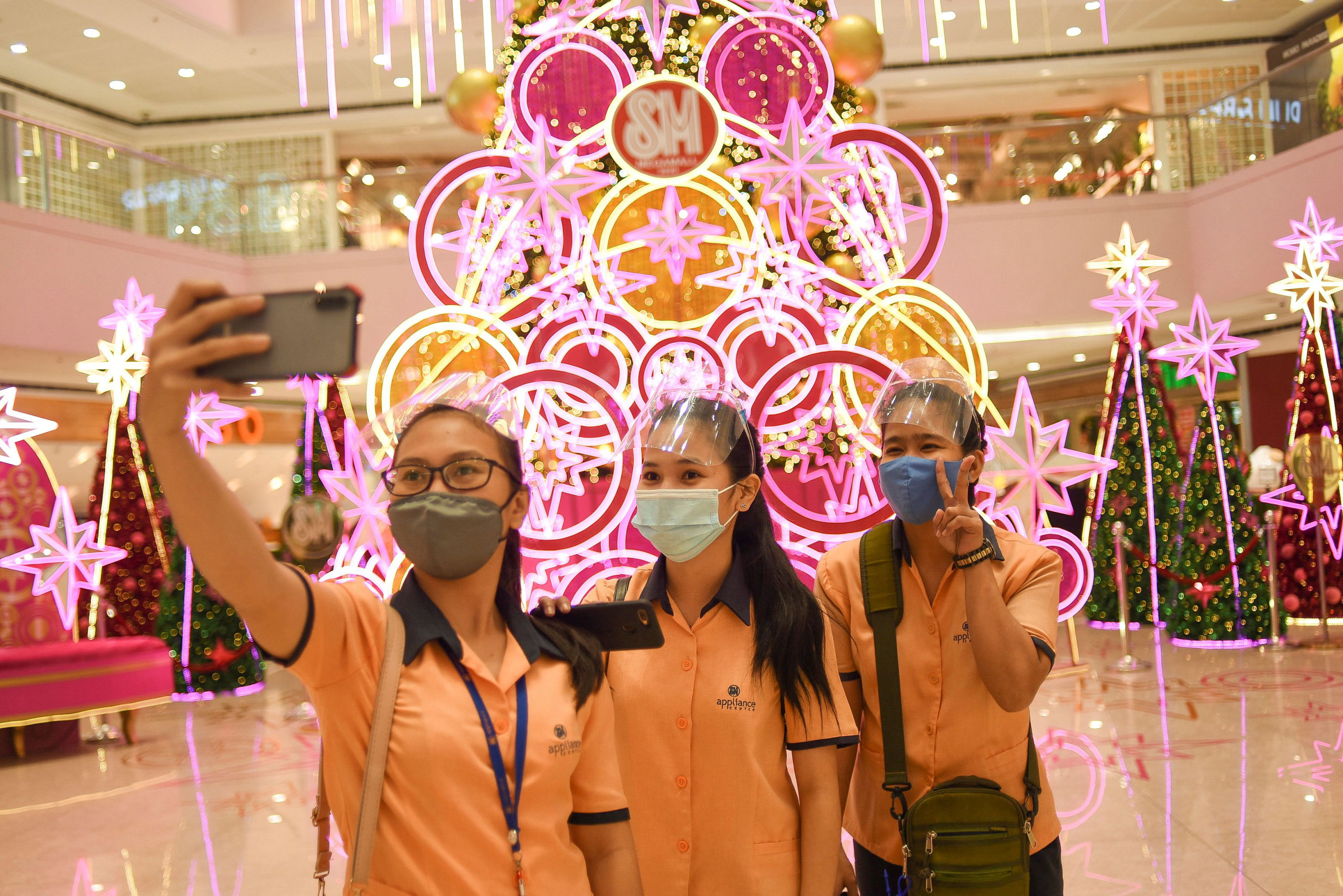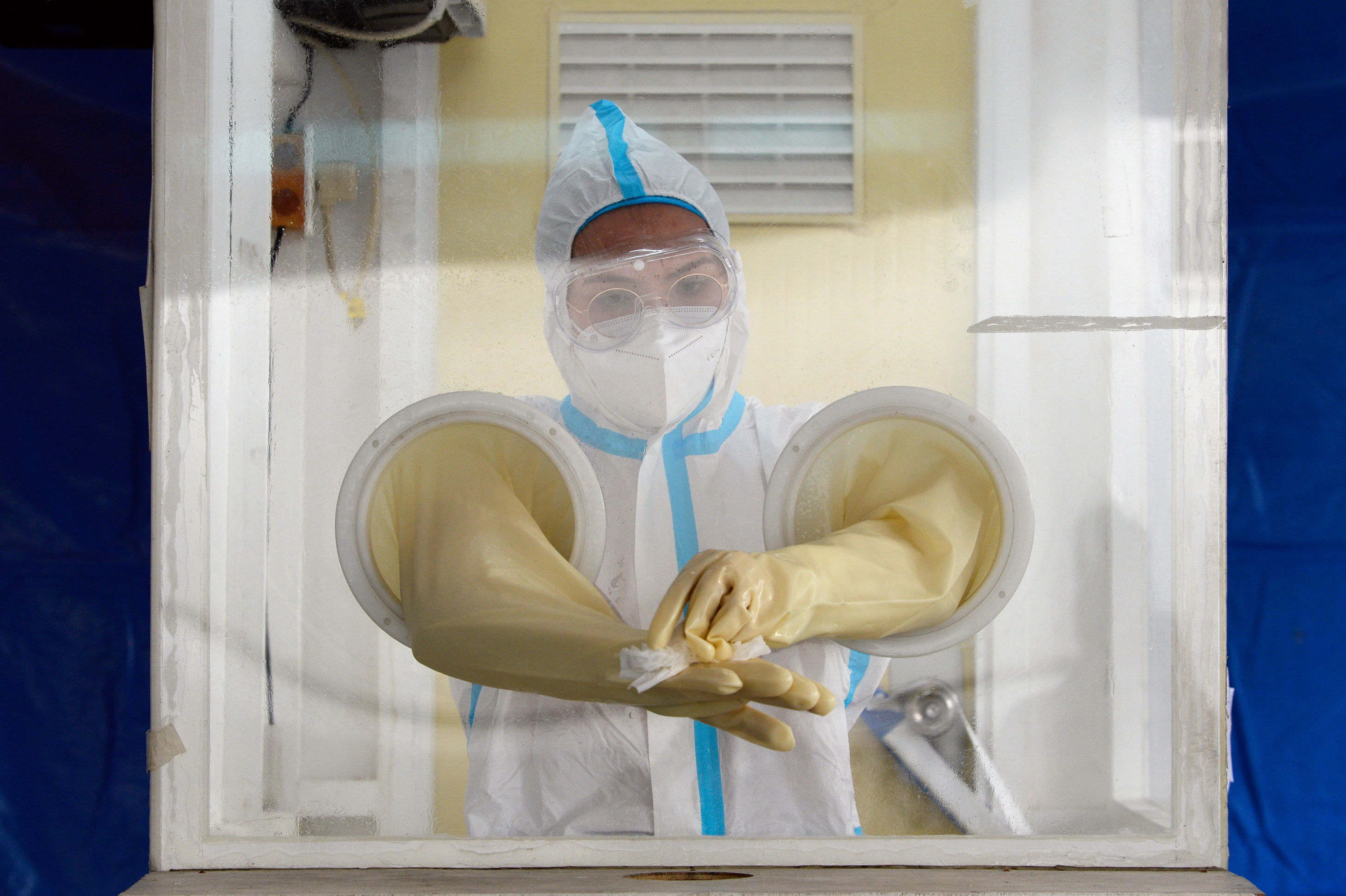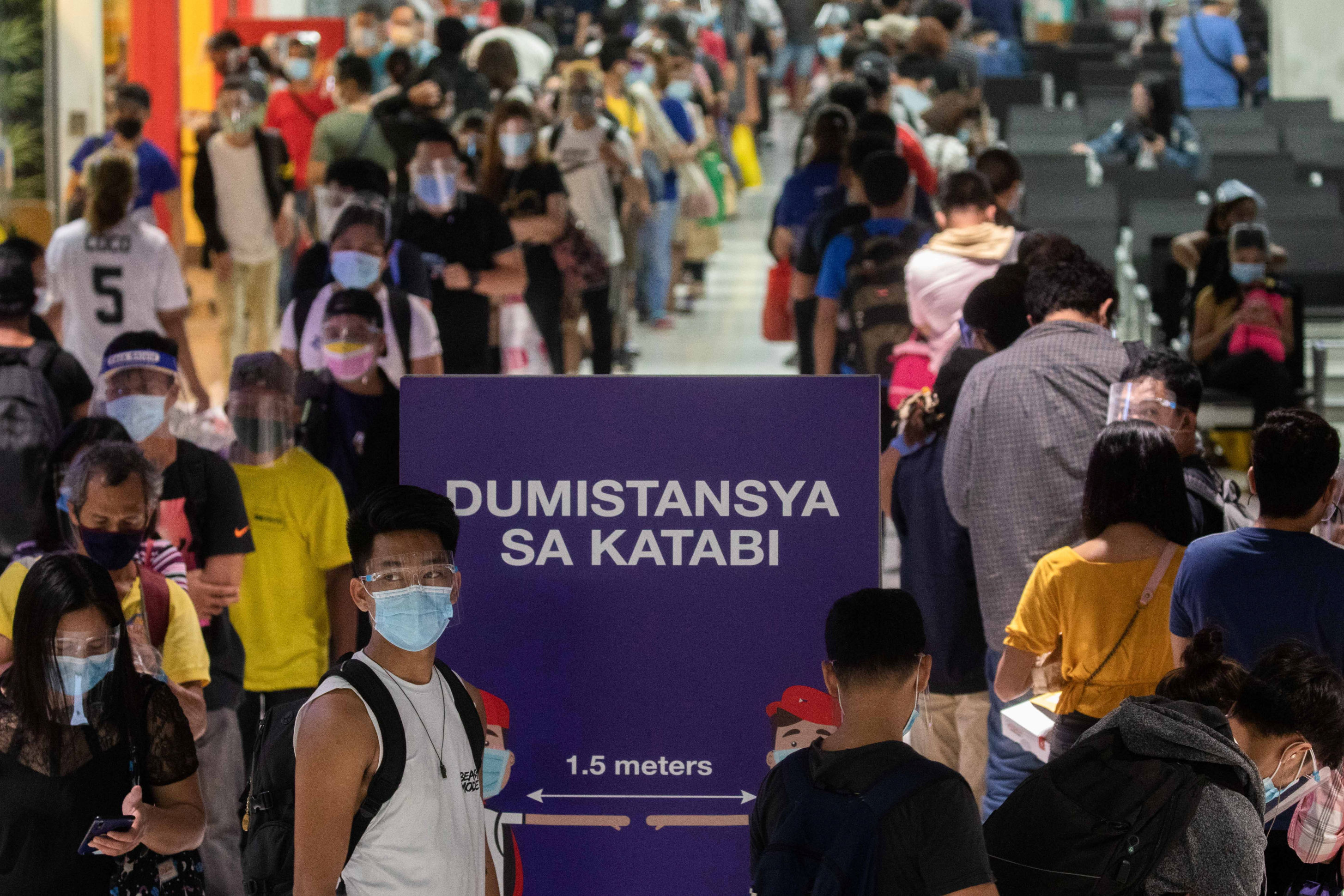We use cookies to ensure you get the best browsing experience. By continued use, you agree to our privacy policy and accept our use of such cookies. For further information, click FIND OUT MORE.
By JULIA MARI ORNEDO
December 31, 2020
Children use a broken umbrella at a park in Baseco compound, Manila, Philippines, December 16, 2020. REUTERS/Lisa Marie David
COVID-19 is at once a global story and a personal one.
For Carlo Navarro, it began with chills and a cough upon his return from Japan, and then a confirmation that he was the first Filipino to be diagnosed with the coronavirus.
“It was not the physical pain that is frightening. It was the psychological effect that made it difficult,” he wrote later. He put on a brave face for his wife and daughter, but continued to worry — for himself, his family, and for others who would not have the means to survive a lockdown.
After two weeks in the hospital he was discharged with no further symptoms, but came away with a passionate plea for others to get tested to protect those around them.
For Nida Paqueo, it also began with coronavirus symptoms. But it ended with her death a mere 11 days later.
Nida’s loved ones, however, are faced not with an end but a continuation: of life without her. “It’s going to be very challenging to get through this Christmas season without her. But then every day is kind of like that, right?” said her daughter Liza.
And for journalist Howie Severino, it continues with the lasting designation of Patient 2828.
“When I got sick with COVID, I was uncertain I would survive,” he wrote. “Four people I knew got sick around the same time; none of them made it, but I did and wondered why. Then there was the uncertainty about what I could physically do with all the lingering effects of the disease. After I recovered, I found myself with a new identity with an uncertain purpose.”
On Rizal Day, the Department of Health reported the infection of Patient 472,532 when it recorded 1,014 new cases. As of December 30, recoveries have reached 439,509, while the death toll rose to 9,230.
The daily number of cases had reached thousands, going up to as high as 6,958 on August 10.
COVID-19 has already claimed more than 1.8 million lives and infected nearly 80 million people worldwide.

A woman takes a selfie with her friends in front of Christmas trees at a mall, in Mandaluyong City, Metro Manila, Philippines, December 9, 2020. REUTERS/Lisa Marie David
It began with news of a concerning sickness in another part of the world. While holiday festivities were in full gear in the Philippines and the rest of the world in the final months of 2019, China was dealing with a mysterious “pneumonia” outbreak in the city of Wuhan.
As 2020 came around, Chinese experts and the World Health Organization scrambled to decipher the illness that had patients suffering fever, cough and colds, and other flu-like symptoms.
Countries began placing restrictions on visitors from China. In the Philippines, the Department of Health (DOH) ordered stricter border control barely a week into 2020.
Then China enforced a lockdown on Wuhan and other cities to stem the spread of the sickness. By this time, other countries had begun banning the entry of visitors from China, or those who had been in China the past fourteen days.
Perhaps many people at the time expected the situation to be a brief pause from the norm. But it has dragged on to become a year-long ordeal marked by isolation and harrowing loss as the world struggled to get control of an outbreak that grew into a deadly pandemic, with no end in sight.
Filipinos ended the first month of the new year with anxieties over the respiratory disease, caused by what had been dubbed the 2019 novel coronavirus (2019-nCoV).
The country stopped issuing visas upon arrival to visitors from China, but two days later came the confirmation that the virus had made its way into the country through a 38-year-old woman from Wuhan, the virus epicenter. She became known as Patient 1.
President Rodrigo Duterte denied entry to travelers from Hubei and other areas in China hit by the 2019-nCoV, but only after the first case in the Philippines was recorded.
The ban was later extended to cover the whole of China as well as its special administrative regions.
It was a sad Christmas for the family of Nida Paqueo, the first Filipino casualty of COVID-19.
In the weeks that followed, however, it became increasingly apparent that the virus had already taken hold in the country long before the travel restrictions were put in place.
On February 2, the same day the ban was enforced, the DOH reported the Philippines’ second case and the first 2019-nCoV fatality outside of China.
Patient 2 was the 44-year-old Chinese male companion of Patient 1. They entered the country through Hong Kong 10 days before the Philippines shut its doors to travelers from virus-hit nations.
As retailers expressed concern over the shortage of masks, Duterte blasted public “hysteria” over the virus: “If there is really a virus going around, why do you have to be hysterical? Why don’t you just go to the hospital and have yourself treated?”
Days later, the Philippines tallied its third case: a 60-year-old Chinese woman from Wuhan who had also entered the country way ahead of the ban that was meant to keep the virus out.
On February 11, the WHO announced the official name for the disease caused by the novel coronavirus: COVID-19.
In the early days of the outbreak in the Philippines, media was still able to observe each individual new infection. But infections picked up quickly in March as the Philippines slowly mounted more testing laboratories, in stark contrast to an oddly quiet February that saw no other cases apart from the three Chinese travelers.
On March 11, Nida Paqueo passed away.
Until then known only to the public as Patient 35, Nida was a “healthy and fit” 67-year-old who was hospitalized due to localized pneumonia just days prior to her death. “She died alone without her loving family and friends around her. She was cremated, alone, without ceremony or tribute,” her daughter said in a heartbreaking Facebook post that went viral.

A health worker wearing a protective suit amid the coronavirus disease (COVID-19) pandemic disinfects her hands at a testing station, in Makati City, Metro Manila, Philippines, December 21, 2020. REUTERS/Lisa Marie David
The Philippines would mark more than just the first Filipino COVID-19 fatality in March.
A “community quarantine” aimed at stemming COVID-19 transmission came into effect over Metro Manila on March 15 as infections rose to 111 with eight deaths.
The following day, Duterte announced an expansion of restrictions to an “enhanced community quarantine” (ECQ) that covered the entirety of Luzon.
Under the ECQ, most Filipinos were under strict stay-at-home orders as public transportation was suspended, the provision of food and health services was regulated, and the presence of uniformed personnel to enforce restrictions was heightened.
Businesses that were deemed “non-essential” were shut, while many employees whose jobs allowed them to work remotely began to work from home.
Filipinos quickly grew familiar with the government’s pandemic lexicon: ECQ is the most stringent risk classification, followed by the modified ECQ (MECQ), the general community quarantine (GCQ), and the modified GCQ (MGCQ), where restrictions are most lax.
Politicians, meanwhile, jostled their way to the front of the queue to be tested for the virus — even as officials denied this was happening — while ordinary Filipinos were forced to wait in anguish for days or even weeks for test results.
For many of these ordinary Filipinos, the test results came back too late.
The lockdown that Duterte declared in March, meanwhile, has since become the longest in the world, with the government showing no intentions of letting up even as 2020 comes to a close.
In what has turned out to be the longest COVID-19 lockdown in the world, Filipino residents lamented the slow pace and inefficiency of aid distribution, especially among the poorest, moving some to tears.
The strict quarantine spelled tough times for many Filipinos, whose livelihoods and sources of income were hobbled by the restrictions on travel and going out.
On March 30, two weeks into the ECQ, the government unveiled a P200-billion cash aid plan for low-income families hit hard by the pandemic. But the distribution of the financial assistance was marred by hours of waiting that lasted well into dawn, as authorities struggled to cope with an ever-growing line of beneficiaries crammed together in gymnasiums.
The government paid out nearly P100 billion to over 17.7 million beneficiaries during the distribution of the first tranche of aid.
After months of stringent lockdown that proved to be unsustainable, Duterte loosened restrictions in Metro Manila on June 1, allowing many sectors to partially resume operations and more people to leave their homes.
The announcement was not met with a sigh of relief from Filipinos who had spent many agonizing weeks under lockdown. Instead, the public was concerned that the country would pay a high price for easing restrictions too soon.
Fears about a premature relaxation of regulations quickly came true. On August 1, the medical community made a resounding plea for a two-week “timeout” after several weeks of four-digit daily new infections that left many healthcare workers extremely fatigued and resources stretched too thin.
Two days earlier, the new daily case count breached 3,000 for the first time — as the DOH also reported its first “mass recovery” number of 38,000, which it attributed to “enhanced data reconciliation efforts with local governments.”
Enraged by the health workers’ public call for a reprieve, Duterte accused them of trying to demean the government before ultimately allowing Metro Manila and other nearby provinces to revert to an MECQ for two weeks.
An expert later said the timeout helped, driving down infections to a more manageable level. “In a way, we did achieve what we wanted to do. We wanted to slow down the pandemic and it did,” Professor Guido David of the OCTA Research group said.
The number of cases, however, continued its steady climb, as did the deaths. On August 6, the Philippines overtook Indonesia as Southeast Asia’s COVID-19 hotspot with 119,460 confirmed cases and 2,150 deaths.

People wear face masks and face shields amid the coronavirus disease (COVID-19) outbreak, in Manila, Philippines, December 17, 2020. REUTERS/Lisa Marie David
But even after most areas across the country returned to the more relaxed GCQ, the Philippines enjoyed a steady downtrend in new infections during the highly anticipated “ber” months. Headlines were no longer about yet another record-high number of new cases but instead focused on promising developments in the search for a COVID-19 vaccine abroad.
While President Duterte expressed his preference for China-made vaccines, as well as for Russia’s vaccine, Sputnik V, Western pharmaceutical and biotech companies were making huge strides.
In mid-November, American multinational Pfizer and its German partner BioNTech announced 95% efficacy for their vaccine, while US firm Moderna said its vaccine was 94% effective. British-Swedish drugmaker AstraZeneca, whose work on a vaccine with Oxford University was highly anticipated, stumbled by inadvertently giving many of its trial subjects a half-dose to start. The half-dose followed by a full second dose, however, resulted in higher efficacy than two full doses.
By the end of November, the Philippines had secured 2.6 million doses of the AstraZeneca vaccine with the help of the private sector.
Vaccine czar Secretary Carlito Galvez Jr., meanwhile, announced the government’s plan to inoculate 20 million Filipinos annually for five years.
The world also reached another pandemic milestone when the United Kingdom launched a massive COVID-19 vaccination campaign shortly after it became the first country to authorize the Pfizer-BioNTech vaccine for use. The first inoculation of the vaccine on a member of the British public was done by Filipina-British nurse May Parsons.
Bahrain, the United States, Canada, and Singapore quickly followed suit in granting emergency use authorization to the Pfizer-BioNTech vaccine.
However, hopes for a better year ahead were dampened by news of fresh surges in COVID-19 infections across the world, including in the Philippines, where experts sounded the alarm on an uptick of new cases driven by the holiday season.
Days before Christmas, the OCTA Research group urged tighter border control after warning that the holiday surge had started in Metro Manila. “While it can be argued that the numbers are still relatively small, the rise in the reproduction number as well as the rise in new cases in the NCR over the last week is the highest for the last two months,” they said. “This is a serious cause for concern.”

Passengers wearing face masks and face shields for protection against COVID-19 queue for bus rides going to provinces amid the holiday season, at the Paranaque Integrated Terminal Exchange, December 29, 2020. REUTERS/Eloisa Lopez
Flaring anxieties even further, experts announced that a new variant of SARS-CoV-2, the virus that causes COVID-19, was discovered in the UK.
Variant B.1.1.7 is largely believed to be more contagious but evidence is yet to confirm whether it makes COVID-19 more severe.
Many nations were quick to shut their doors to Britain, including the Philippines, which will keep travelers from the UK out until the middle of January 2021.
“I’m telling you there is no way of knowing how this thing will evolve. It is evolving, itong (this) new strain. But how far, how fast is the progression, wala pa tayong alam (we don’t know anything yet),” Duterte said in a national address.
The new variant has so far been detected in several countries, including Canada, Portugal, Norway, Hong Kong, Singapore, and Australia.
The Philippines has extended the travel ban to more countries.
AstraZeneca said its vaccine should still be effective against B.1.1.7, while Pfizer’s German partner, BioNTech, and Moderna are rushing to test their vaccines against the new variant.
These come amid the government making missteps and highly controversial decisions along the way.
In mid-December. Foreign Secretary Teodoro Locsin Jr. accused an unnamed official of “dropping the ball” when it came to securing the Pfizer-BioNTech vaccine for the Philippines. Senator Panfilo Lacson and Ambassador to the United States Manuel "Babe" Romualdez would later identify the official as Health Secretary Francisco Duque.
Duque and other officials such as Galvez, the vaccine czar, denied any shortcoming on their part, but the Philippines still has not secured an order for the Pfizer-BioNTech and Moderna vaccines.
Duterte, meanwhile, let slip that some military personnel had already been inoculated, even though the Food and Drug Administration has not yet approved any of the vaccines now available.
The chief of the Presidential Security Group admitted that they got a vaccine for free from a “source,” but refused to identify them. The Food and Drug Administration said that this is a breach of the regulatory process.
In the face of a new variant, it remains to be seen whether in 2021 the world will have learned its lesson from the initial outbreak or if we will stay on the same path that we started out on in 2020.
But as 2021 approaches, Filipinos appear to be ending this year in the same way they started it: full of apprehension over the threat of the virus, and questions over the government’s handling of the crisis.
Editing by Barbara Marchadesch.